In the rear view mirror
By Georges Bertola
It was Philippe Pierlot (Vive les échecs! Ed. Olibris) who first drew my attention to this extraordinary woman.
During the last Paris Grand Chess Tour, a Parisian player, Emmanuel Delhoume, proposed a meeting with Isabelle Choko. I went to Boulogne with GM Bachar Kouatly. It was a poignant and moving meeting with a lady, cultured, dynamic, mischievous and, despite a very painful past, she remains confident in the future. It was a salutary lesson in life such as one receives only too rarely.
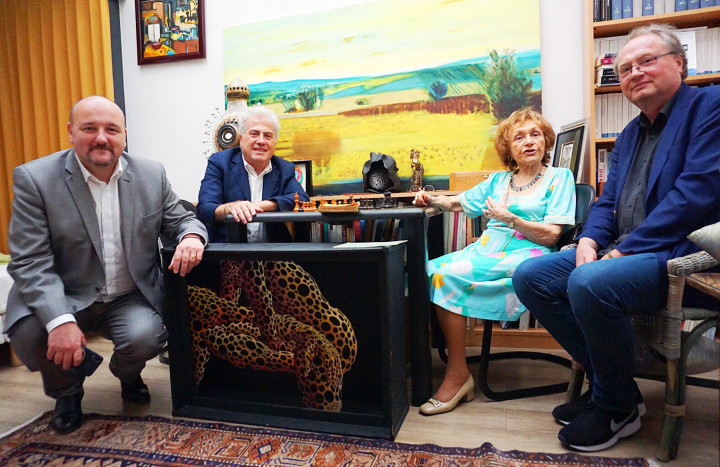
Emmanuel Delhoum, Bachar Kouatly, Isabelle Choko et Georges Bertola
Survivor of the Shoah
Isabelle Choko had a happy childhood in Lodz, Poland, in a wealthy family, pampered by her parents. But in September 1939, the Germans invaded Poland and the Second World War began. "That's when my life changed. Nothing would ever be the same again. My childhood ended at that moment. I was almost eleven years old," she says.
On September 8th, the Germans enter Lodz and establish a regime of terror and persecution. On September 17 the Soviet army invades the eastern part of Poland and Poland ceases to exist.
These were the consequences of a secret agreement of the German-Soviet Pact signed on 23 August 1939. Since October 1939, Lodz has been part of the "Reichsgau Wartheland" annexed to the Third Reich and the city is renamed Litzmannstadt. On February 8, 1940, the Lodz ghetto was created. More than 160,000 Jews were confined in the most miserable and dilapidated district of the city: "In this way, families and Jews in general found themselves separated, often isolated, without any possibility of communication. The infernal machine for crushing Jews, Gypsies, homosexuals, Freemasons and all resistance fighters was set in motion."
The Lodz Ghetto
It was in the ghetto that Izabela Sztrauch first saw chess pieces. An aunt and a cousin were playing chess, but she does not remember if that is when she learned how the pieces moved: "We had to work from morning to night. I was in a workshop where I had to weave straw. As you know, straw is sharp, and I came home every night with bloody hands. We were hungry all the time. The Nazis gave us the minimum to work without dying. We had three square metres per person to live in, no heating. It was very complicated and therefore there was no question of learning to play chess. How could I put up with all that, working outside all day for an ersatz coffee, a small piece of bread with a bit of margarine, and in the evening a soup – basically hot water? During the whole war, I only thought about my childhood and my parents. I didn't think about my current situation because there was nothing to think about."
Concentration camp
In September 1942, the Germans, aided by the ghetto police, went from house to house, selecting children, old people, the sick and the unemployed, for deportation. Sick with typhoid, she is hidden by her parents. In December, her father died as a result of deprivation and lack of medicine. In 1944, after trying to avoid deportation by hiding, Izabela and her mother found themselves in the Auschwitz-Birkenau extermination camp. She owes her life only to a gesture by a prisoner who tells her to join the left-hand line with her mother, the line for those fit for work, the side of life. They entered the Waldeslust forced-labour camp, near the Bergen-Belsen concentration camp in Germany. In February 1945, Izabela contracted typhus and in March her mother died.
The girl with the blue eyes
On 15 April 1945, the British army succeeded in liberating the Bergen-Belsen camp. Izabela is in a desperate state: "I was so unrecognizable, my body was like all the corpses in Bergen-Belsen, you could only see my bones. I could only move my head, that's all. I couldn't move my body. The head resisted, I could speak and move my pupils. That's why my children chose the title of my book: The girl with blue eyes." Transferred to a makeshift hospital next to the camp, she was saved, and in June she went to Sweden to be reborn and receive treatment in a hospital in Norrköping. She learned that her uncle in Paris was alive and arrived in France in February 1946. "I was happy with everything after the war, everything seemed perfect. There was one thing that was positive, I wasn't afraid of anything any more!"
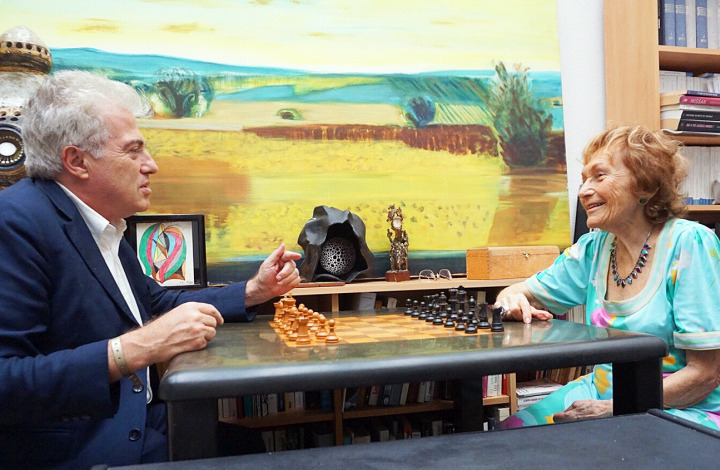
GM Bacher Kouatly, editor of Europe Échecs, talking with Isabelle Choko
New life in France
In France she met Arthur Choko and got married in December 1946. She gave birth to three sons: "When I arrived in France, my little cousin was playing chess. That's when I learned the movement of the pieces. My husband also played and, in 1954, we went on holiday to Vittel. People were playing chess in front of the spa and that's when I really started to play. After a few games, a player said to me: "Do you know that you are gifted. You should join a chess group. I lived in Saint-Maur-des-Fossés where there was only one chess club. But at least there was one! It reminds me of a funny story. Someone went to Russia and found himself in a little village. He asked for the address of the chess club. Which one, they asked. I went to the club with my eldest son and at home we started playing chess regularly. "
Chantal Chaudé de Silans
Madame Choko joined the famous Parisian club of Caïssa: "It was there that I met Madame Chantal Chaudé de Silans, who became a friend. In 1957, in Emmen in Holland, we took part, together, in the first women's world team championship. General de Gaulle, whom I liked very much, disappointed me because, when he was asked for money for participation in this championship, he replied: 'Why not for pétanque [boules]! He immediately sank in my esteem... How can one compare pétanque with chess? So, we had no money and stayed with a local citizen. I was staying with a doctor whose newborn baby was crying all night. Meanwhile, the American and German girls, in the first class hotel, were accompanied by masters, who analysed their adjourned games while they slept. Can you imagine the difference! We still managed to win Section B."
Tartakover and Baratz
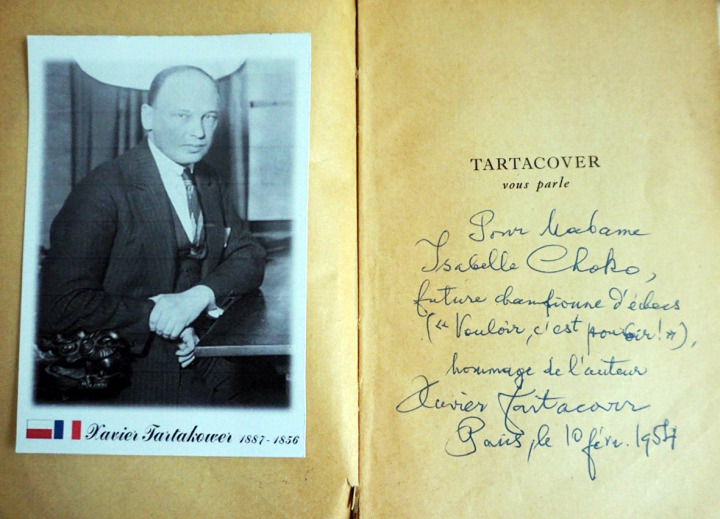 I met Savielly Tartakower several times, and he dedicated his book "Tartakover vous parle" to me, writing: "To the future French Champion." He planned it! It was a year before I got the title. He was great, he was a funny and charming man. I also knew Rossolimo, but he left for the United States. He was fed up with not earning a penny playing chess for France. But I learnt most of all from Abraham Baratz, several times Paris champion, because, as usual, I didn't do things like the others, I didn't want to study openings, it bored me. Of course, sometimes I had bad surprises, but I learned the openings by playing. I didn't like theory. Baratz knew my way of playing, and he said to me: "It's not complicated, you manage to occupy the centre. You have to be the master of the centre, and then you see how you can get your opponent's king!"
I met Savielly Tartakower several times, and he dedicated his book "Tartakover vous parle" to me, writing: "To the future French Champion." He planned it! It was a year before I got the title. He was great, he was a funny and charming man. I also knew Rossolimo, but he left for the United States. He was fed up with not earning a penny playing chess for France. But I learnt most of all from Abraham Baratz, several times Paris champion, because, as usual, I didn't do things like the others, I didn't want to study openings, it bored me. Of course, sometimes I had bad surprises, but I learned the openings by playing. I didn't like theory. Baratz knew my way of playing, and he said to me: "It's not complicated, you manage to occupy the centre. You have to be the master of the centre, and then you see how you can get your opponent's king!"
French champion!
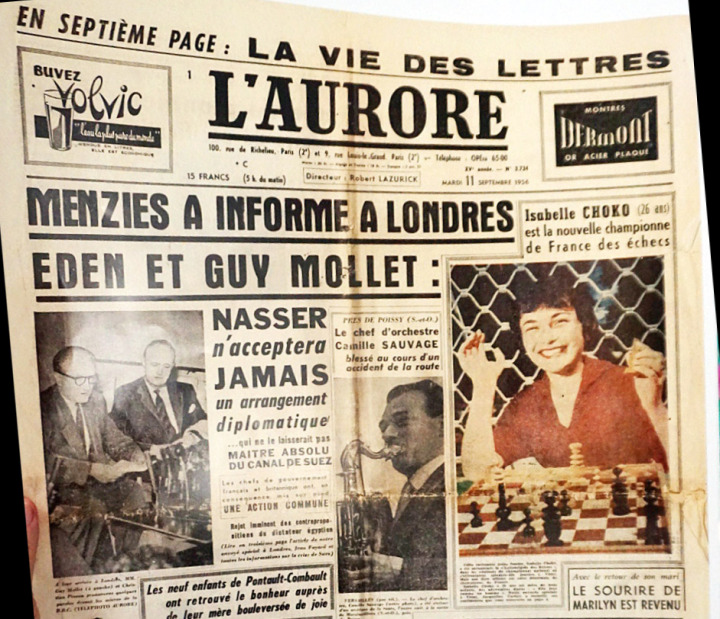 In 1956, in Vittel, she became French champion: "My dear Arthur had warned everyone that his wife was going to win the French Women's Championship, so all I had to do was to play.
In 1956, in Vittel, she became French champion: "My dear Arthur had warned everyone that his wife was going to win the French Women's Championship, so all I had to do was to play.
When I finished the last game, just before the official proclamation of my title of French Champion, there was a person in the audience who demanded that my identity papers be checked. Indeed, only a French national could compete for the title. I was very angry and said that if my identity card had to be checked, it should have been done before and not when I had just won the title. But this incident did not change the reality of things, I had French nationality, and I was indeed the French Chess Champion in 1956."
Here is a victory against the 1955 and 1957 French champion.
A nod to misogyny
In the early 1950s, few women dared to walk through the door of a chess club: "Sometimes I would be in across from men who didn't know me. I'm sitting in front of the chessboard and I see a very smiling gentleman come in and sit down and kiss my hand. At the same time he looked at me and said: "I have no intention of letting a woman win." The implication was that, being a woman, and therefore necessarily less strong, I could not win. To which I replied with a smile: "But who's asking you?" Needless to say, he was very careful and despite this, he lost the game." – Isabelle Choko - Boulogne, 1 August 2019 |
Friend of artists
Isabelle Choko pursued and explored several fields, before she started taking care of artists – more precisely painters – by organising numerous exhibitions: "I did many things since I had no profession! No, real artists, painters, it's their life. They can't do anything else on the side. This also seems to be true of great chess players. I chose family, I needed to have a family, but, as soon as I could, I helped artists by organising exhibitions, sales, to enable them to live, and me too."
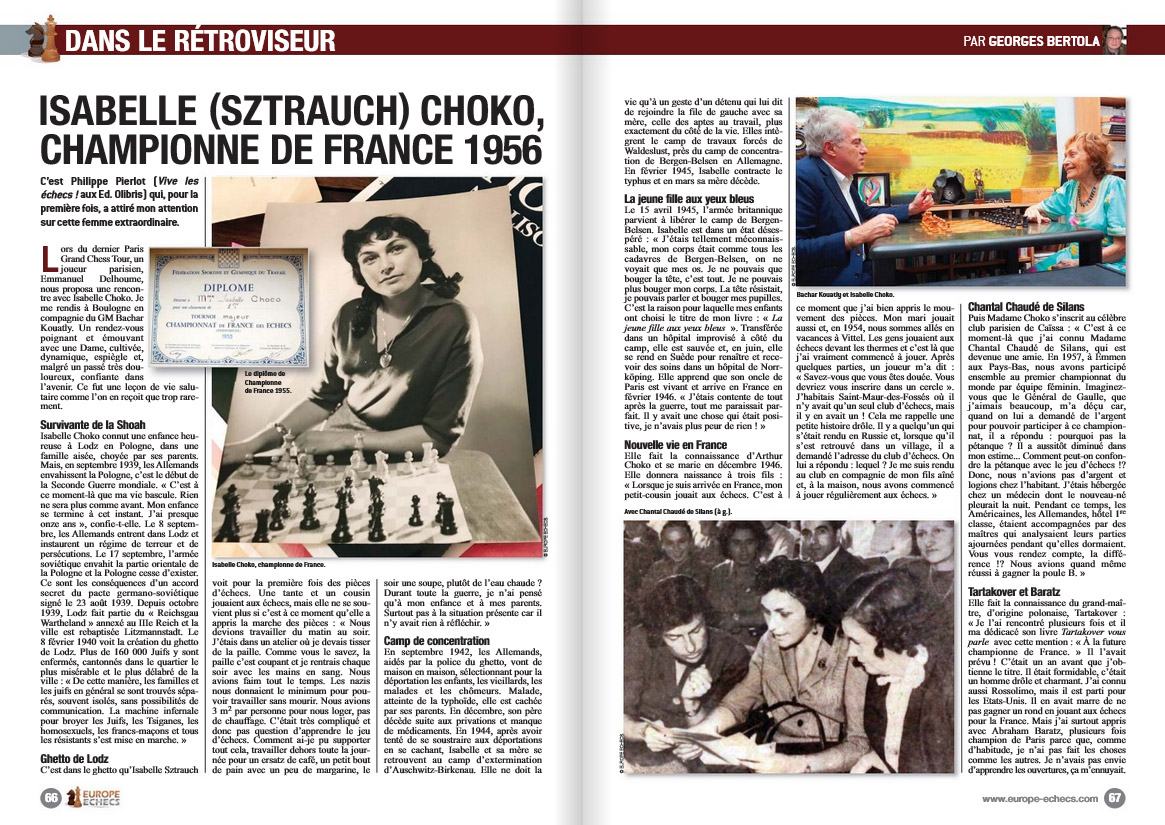
The above portrait appeared in the French chess magazine Europe Échecs and is reproduced here with kind permission.
.jpeg)



















 I met Savielly Tartakower several times, and he dedicated his book "Tartakover vous parle" to me, writing: "To the future French Champion." He planned it! It was a year before I got the title. He was great, he was a funny and charming man. I also knew Rossolimo, but he left for the United States. He was fed up with not earning a penny playing chess for France. But I learnt most of all from Abraham Baratz, several times Paris champion, because, as usual, I didn't do things like the others, I didn't want to study openings, it bored me. Of course, sometimes I had bad surprises, but I learned the openings by playing. I didn't like theory. Baratz knew my way of playing, and he said to me: "It's not complicated, you manage to occupy the centre. You have to be the master of the centre, and then you see how you can get your opponent's king!"
I met Savielly Tartakower several times, and he dedicated his book "Tartakover vous parle" to me, writing: "To the future French Champion." He planned it! It was a year before I got the title. He was great, he was a funny and charming man. I also knew Rossolimo, but he left for the United States. He was fed up with not earning a penny playing chess for France. But I learnt most of all from Abraham Baratz, several times Paris champion, because, as usual, I didn't do things like the others, I didn't want to study openings, it bored me. Of course, sometimes I had bad surprises, but I learned the openings by playing. I didn't like theory. Baratz knew my way of playing, and he said to me: "It's not complicated, you manage to occupy the centre. You have to be the master of the centre, and then you see how you can get your opponent's king!" In 1956, in Vittel, she became French champion: "My dear Arthur had warned everyone that his wife was going to win the French Women's Championship, so all I had to do was to play.
In 1956, in Vittel, she became French champion: "My dear Arthur had warned everyone that his wife was going to win the French Women's Championship, so all I had to do was to play.





